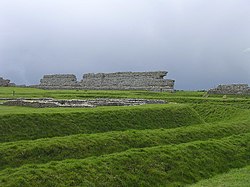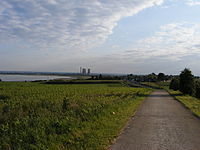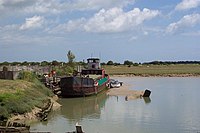Richborough
| Richborough | |
| Kent | |
|---|---|
 The remains of Rutupiæ | |
| Location | |
| Grid reference: | TR315605 |
| Location: | 51°17’47"N, 1°19’9"E |
| Data | |
| Post town: | Sandwich |
| Postcode: | CT13 |
| Dialling code: | 01304 |
| Local Government | |
| Council: | Dover |
| Parliamentary constituency: |
South Thanet |
Richborough, once the major port town of Roman Britain, is today a hamlet in Kent. It is a place barely identifiable these days, by the county's eastern coast north of Sandwich and on the course of the River Stour south of the bounds of the Isle of Thanet.
Although now some distance from the sea, Richborough stood at the southern end of the Wantsum Channel from prehistory to the early Middle Ages. The channel provided a sheltered route for ships from Europe into the Thames estuary and separated the Isle of Thanet from the mainland.
The Wantsum Cannel has now silted up. When it was a navigable water though, Richborough was an important natural harbour. It is believed to have been the landing place of the Roman invasion of Britain in AD 43.[1] Though the invasion site is a matter of scholarly debate (Chichester Habour is anoher candidate), in October 2008 two ditches were found at Richborough dated to the Roman period which have been interpreted as defensive structures protecting the beachhead, as the ditches would have protected 750 yards of coast.[2]
Contents
Roman and Saxon history
- Main article: Richborough Castle
The Romans founded a port on the Wentsum Channel named Rutupiae, which is to be found beside the River Stour to the north of Sandwich and south of Richborough Port, beside Richborough Farm. It became the major port from Roman Britannia and the beginning of the great road to Londinium, now known as Watling Street. At Rutupiae was a Roman fortress, port and town with an impressive amphitheatre, the remains of which are all visible and in the care of English Heritage.
The fort of Rutupiae was transformed in the third century, probably by Carausius, who ruled as Emperor of Britain, into a major fort of the Saxon Shore, now known as Richborough Castle.
After the Romans withdrew from Britain, the site was occupied by a Saxon religious settlement, honoured because St Augustine landed in 597 at nearby Ebbsfleet on Thanet.
English Heritage run historical events on the site throughout the summer.
Secret Harbour of 1916
During the First World War the capacity of Dover and other nearby ports was found to be inadequate, and a major harbour was constructed at Richborough. Its purpose was to provide the British Expeditionary Force with its heavy equipment (tanks, guns, railway locomotives, ammunition, horses and fuel).
In 1917, the Government began to look into the possibility of installing a cross-Channel train ferry at Richborough to allow Roll-on/roll-off transportation of railway rolling stock, artillery and supplies to the allied Front Lines. This was the first time that sea-going Roll-on/roll-off ferries had been used from Britain.[3] Three new train-ferries were built and operations began on 10 February 1918, conveying nearly 900 tons of cargo at a time between Richborough and Calais and Dunkirk. Although existing barge services were still in operation across the Channel from Richborough, the use of train-ferries was more practical for larger and heavier cargos, such as tanks.
The use of train-ferries greatly reduced the amount of labour required in the transport of these items as it took only 30 to 40 minutes to load or unload the 54 railway wagons and fifty or sixty motor vehicles that could be carried by these train-ferries.[4] An analysis done at the time found that to transport 1,000 tons of war material from the point of manufacture to the front by conventional means involved the use of 1,500 labourers, whereas when using train-ferries that number decreased to around 100 labourers.[5]
To accommodate for train-ferries, a new type of terminal had to be designed and built at Richbrough, Calais and Dunkirk. Adjustable steel bridges with two sets of railway lines, spanning between 80 and 100 feet depending on the local conditions at the each port, were installed at each of the three ports to allow a true connection between railway lines on shore and the tracks on the ferry.[4]
By mid-1918 Richborough's war port had become a very large site, occupying 2000 acres and capable of handling 20,000 tons of traffic each week.
After the signing of the Armistice on 11 November 1918, train ferries were used extensively for the return of material from the Front. Indeed, according to war office statistics, a greater tonnage of material was transported by train ferry from Richborough in 1919 than in 1918. As the train ferries had space for motor transport as well as railway rolling stock, thousands of lorries, motor cars and "B Type" buses used these ferries to return to England.[5]
Richborough Power Station
The Richborough Power Station was opened, within the port, in 1962 burning coal as its fuel. In 1971 it was converted to run on oil before it was finally converted again during the final years of operation to burn the controversial fuel Orimulsion (an emulsion originating from the Orinoco Basin, which was offloaded here). The plant closed down in 1996, but much of it remained in situ until the demolition of the three cooling towers on 11 March 2012. A new Energy Park is planned for the site.
Miscellany
The Bishop of Richborough is one of the two provincial episcopal visitors for the Province of Canterbury, along with the Bishop of Ebbsfleet, each being a suffragan bishop of the Province. The provincial episcopal visitors provide alternative episcopal oversight for parishes in the Province which do not accept the women in the priesthood. The office of Bishop of Richborough was created in 1995.
Outside links
| ("Wikimedia Commons" has material about Richborough) |
- Album Richborough, at stoa.org
- Richborough Roman Fort and Amphitheatre Richborough Roman Fort page at English Heritage
References
- ↑ Dig uncovers Roman invasion coast - BBC News
- ↑ Roman invasion beach found in Kent - Archaeologists unearth landing point of legions – only now it's two miles from the coast
- ↑ The Times History of the War: Volume XXI Book. London: The Times. 1920.
- ↑ 4.0 4.1 Pratt, Edwin A (1921). British Railways and the Great War Book. London: Selwyn and Blount, Ltd.. ISBN 1151852406. https://archive.org/stream/cu31924092566128#page/n7/mode/2up.
- ↑ 5.0 5.1 Butler, Robert (1999). Richborough Port. Sandwich Local History Society.
Books
- Bushe-Fox J. P., Third report on the excavations of the Roman fort at Richborough, Kent, Oxford: The University Press; London: The Society of Antiquaries, Reports of the Research Committee of the Society of Antiquaries of London 10, 1932 (BSA)
- Bushe-Fox J. P., Fourth report on the excavations of the Roman fort at Richborough, Kent, Oxford: The University Press; London: The Society of Antiquaries, Reports of the Research Committee of the Society of Antiquaries of London 16, 1949 (BSA)
- Butler Robert, Sandwich Haven and Richborough Port, Sandwich Local History Society, 1996
- Cunliffe B. W., Fifth report on the excavations of the Roman fort at Richborough, Kent, Oxford: The University Press: for the Society of Antiquaries, Reports of the Research Committee of the Society of Antiquaries of London 23, 1968 (BSA)
- Johnston D. E., The Saxon Shore, London: Council for British Archaeology, CBA Research Report 18, 1977
- Pratt Edwin A. British Railways and the Great War, London Selwyn and Blount, Ltd., 1921

